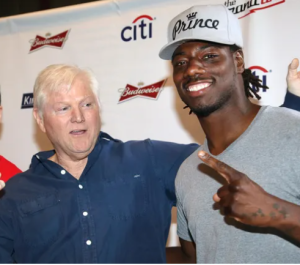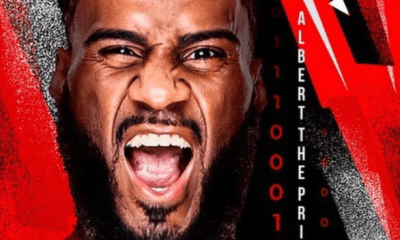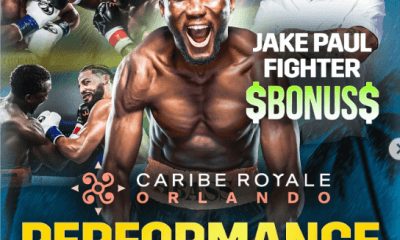Featured Articles
Charles Martin: “I’m a young 37 and have never been more passionate about boxing”

Jared Anderson was slated to fight Kazakhstan’s Zhan Kossobutskiy on July 1 on ESPN in a match emanating from the 9,000-seat Huntington Center in Toledo, Ohio. That match-up fell out, purportedly because Kossobutskiy had visa problems. In steps Charles Martin and now the stakes are higher for Jared Anderson.
Anderson, a mere pup for a heavyweight at twenty-three years of age, has knocked out all 14 of his opponents at the professional level. Only two lasted beyond the third round. Hailed as the next great American heavyweight and a sure-shot future world champion, the Toledo native is on the path to becoming a very rich man.
Zhan Kossobutskiy’s record is no less impressive: 19-0 with 18 knockouts. However, Charles Martin (29-3-1, 26 KOs) is in some ways a more credible opponent.
Won-loss records in boxing are notoriously misleading and that’s especially true for a relative unknown who has never fought on American soil. Knowledgeable fans who have studied Kossubutskiy’s fights on youtube have told this reporter that he is legit and it’s worth noting that he defeated future Olympians Vassiliy Levit, Guido Vianello, and Frazer Clarke in his amateur days. However, the fact remains that as a pro, akin to Jared Anderson, he has yet to fight a reputable opponent. One of the few recognizable names on his ledger is Philadelphia journeyman Joey Dawejko. The Kazakh stopped him in the second round in Hamburg Germany, but the usually durable Dawejko came in overweight (a career-high 266 ¾ pounds) and fought as if he were just there for the payday.
If Anderson had fought Kossobutskiy and had blown him away, many pundits would have cushioned their kind words with the caveat that Jared still hasn’t been properly tested. If, perchance, Anderson blows away Charles Martin on July 1, retrospectives won’t command a caveat. “Prince Charles” has certainly been found wanting on occasion, but the St. Louis native has been in with some of the division’s hardest hitters and has the added beguilement of having once been a world title-holder.
His reign didn’t last long. Not quite three months after capturing the vacant IBF title with a quirky third-round stoppage of Vyacheslav Glazkov at Barclays Center in Brooklyn (Glazkov fell and suffered a knee injury), Martin went to London and was blasted out in the second round by Anthony Joshua. He is 6-2 since that mishap, most recently a fourth-round stoppage of 2004 U.S. Olympian Devin Vargas.
Charles Martin

Martin, pictured above with the late Michael King in a 2014 photo, is one of the last remnants of a grand experiment that bore little fruit.
A TV mogul – the family business, King World Productions, syndicated such powerhouses as “Oprah” and “Wheel of Fortune” — Michael King was a diehard boxing fan who built a state-of-the-art gym in Carson, California, with an eye to growing the next generation of great American heavyweights. He thought blue-chip athletes toiling in other sports like football and basketball were the best prospects.
King funneled millions into his pet project with the little to show for it. Six-foot-seven Dominic Breazeale, a former college quarterback, made the U.S. Olympic team and was a two-time world title challenger, but manufacturing a world champion proved to be elusive and King wasn’t there to celebrate when Charles Martin held the IBF belt aloft at the Barclays Center. The previous year, he contracted pneumonia and passed away at age sixty-seven.
Charles Martin, who comfortably carries 245 pounds on a six-foot-five frame, has the look of someone who would have excelled on the hardwood or the gridiron. However, that wasn’t the case. Unlike other heavyweights sponsored by Michael King, Martin, one might say, fell through the cracks.
“I was real skinny in high school and my mother didn’t want me to play football,” says Martin who bounced around in his schoolboy days and was living in Phoenix when he left school in the 11th grade. And basketball? “I was okay playing in the street,” he says, “but lousy in a structured environment.”
What, then, was his best sport? “Bowling,” he says matter-of-factly. He currently plays in two leagues and avouches that his best game was a 269.
Another surprise awaited when Martin was asked to name his favorite boxers. The first name that popped out of his mouth was a Welshman, Joe Calzaghe. The two would seem to have little in common other than both being southpaws.
Since winning the title, Martin’s career has been choppy but there were underlying factors. “I lost my love for boxing after what happened in the Joshua fight,” he says. A full year elapsed before Martin fought again.
Then there was Covid. He’s had two encounters with the debilitating virus, the first popping up following his 2018 match with Adam Kownacki wherein he lost a 10-round decision.
“When I got to JFK Airport, it hit me,” he says. “They say that some people lose their sense of taste and sense of smell when they get it. I didn’t, but when I got home, I was so fatigued that all I wanted to do was stay in bed.”
Martin says that he had another brush with it after visiting his wife’s family in Atlanta. That begs the question of whether he was 100 percent on New Year’s Day of 2022 when Cuban slugger Luis “King Kong” Ortiz saddled him with his third loss. Martin was upright but on unsteady legs when the bout was waived off in the sixth frame.
Martin had Ortiz down twice before the roof fell in. He was ahead on all three cards through the five completed rounds.
“I don’t want to take anything away from Ortiz,” he says. “He hit me with some good shots. But something was wrong with me. After five rounds, I didn’t have any bounce in my legs.”
The setback to Ortiz, he says, had the exact opposite effect of his setback to Anthony Joshua. “After Joshua,” he says, “you couldn’t get me back in the gym unless I had a fight in the works. Now I couldn’t wait to get back in the gym.”
Martin now resides in Las Vegas where there is a sizeable colony of heavyweights. Veterans like Jonnie Rice and Michael Hunter, up-and-comers like Jeremiah Milton, Skylar Lacy, and Patrick Mailata, and a steady stream of European visitors like Joe Joyce have created something of a round-robin vibe in the local gyms where they spar. Oddly, although southpaws are always in demand as sparring partners, Martin says that he has never sparred with Jared Anderson. “I think it’s better that way,” he says, alluding to the fact that neither will enter the ring with any preconceptions.
Martin is the father of seven children. “One of my goals,” he says, “is to get all my kids under the same roof.” The youngest of his children, two-year-old twin boys, have been diagnosed as autistic. He plans to use his upcoming fight as a platform to make the public more aware of this complex disorder.
In handicapping the Anderson-Martin fight, the age gap looms large. “I know this is a young man’s game,” he says, “but I am a young thirty-seven.” And while Martin will be fighting in a hostile setting – this is a “welcome home” fight for Anderson who will be making his first start as a pro in the city where he was born and raised – the match is something of a homecoming fight for him as well. Martin finished his amateur career at a tournament in Toledo.
Based on the odds, Jared Anderson should have little trouble advancing his record to 15-0. Charles Martin stands ready to gum up the works.
-

 Featured Articles3 weeks ago
Featured Articles3 weeks agoThe Hauser Report: Cinematic and Literary Notes
-

 Featured Articles4 weeks ago
Featured Articles4 weeks agoOscar Duarte and Regis Prograis Prevail on an Action-Packed Fight Card in Chicago
-

 Book Review3 weeks ago
Book Review3 weeks agoMark Kriegel’s New Book About Mike Tyson is a Must-Read
-

 Featured Articles1 week ago
Featured Articles1 week agoThe Hauser Report: Debunking Two Myths and Other Notes
-

 Featured Articles2 weeks ago
Featured Articles2 weeks agoMoses Itauma Continues his Rapid Rise; Steamrolls Dillian Whyte in Riyadh
-

 Featured Articles4 weeks ago
Featured Articles4 weeks agoRahaman Ali (1943-2025)
-

 Featured Articles4 weeks ago
Featured Articles4 weeks agoTop Rank Boxing is in Limbo, but that Hasn’t Benched Robert Garcia’s Up-and-Comers
-

 Featured Articles3 weeks ago
Featured Articles3 weeks agoKotari and Urakawa – Two Fatalities on the Same Card in Japan: Boxing’s Darkest Day




















